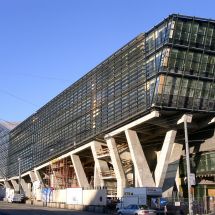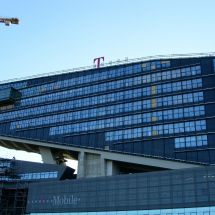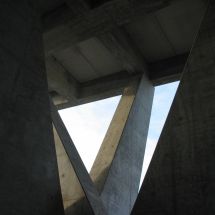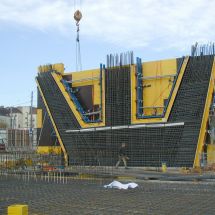T-Center - Austrian headquarters T-Mobile
The Austrian headquarters of the mobile provider T-Mobile was built on the former slaughterhouse area in St. Marx. The expressive building was positioned at a prominent urban location - the Vienna Southeast Tangent. The T-Center was awarded the Otto Wagner Urban Planning Prize in 2004, the State Prize for Architecture for New Working Environments in Administration and Commerce in 2006, as well as The Chicago Athenaeum International Architecture Award.
The Horizontal Skyscraper Instead of building upwards, the architects designed a flat and elongated structure that does not exceed 60 meters at its highest point. The "wing" and the "fingers" define the extravagant appearance of this horizontal sculpture, which impressively shapes the district of St. Marx and effectively represents the telecommunications company located within it. Günther Domenig described his design as a "horizontal skyscraper."
The 2,000 T-Mobile employees have access to shops, restaurants, a kindergarten, and a medical center. A four-star hotel is also part of the plan.
Structural Challenges The "High Wing" section, with a height of 60 meters and a width of 15 meters, consists of two reinforced concrete cores spaced approximately 25 meters apart. The seven floors between the cores are supported by an inclined steel truss, consisting of three longitudinal beams with a height of three meters.
From the central core of the "High Wing," a six-story building extends up to 45 meters. The primary structural system of this projection consists of two four-story trusses, whose uprights simultaneously serve as the inner columns of the 17cm thick composite floor slab. The diagonally inclined truss between the cores and the bottom chord of the trusses form a plane that is penetrated by the central core and the inclined support. The trusses consist of open HD steel profiles connected with gusset plate joints. The axial forces from the trusses are transferred through bending to the concrete cores and through axial force in the inclined support. These inclined supports consist of two two-cell box sections. They continue as compression members in the two truss planes and support an escape staircase. Two additional floors rest on the four structural floors of the projection. The top deck of the high wing is inclined and is made of steel for weight reasons. The two top-level floor slabs in the truss area are prestressed, and a portion of the top chord force of the truss is transferred to the second core through them for balance.
| Client | Deutsche Telekom |
| Architecture | Günther Domenig, Hermann Eisenköck und Herfried Peyker |



